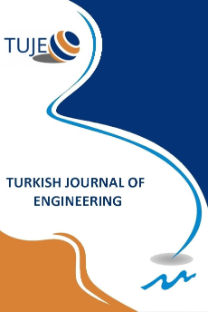REMOVAL OF COD AND SURFACTANTS FROM GREY WATER BY FENTON TYPE PROCESSES
REMOVAL OF COD AND SURFACTANTS FROM GREY WATER BY FENTON TYPE PROCESSES
___
- APHA/AWWA/WEF, 2005. In: Clesceri LS, Greenberg AE, Eaton AD. (Eds.), Standard Methods for the Examination of Water and Wastewater, 21st ed. American Public Health Association, American Water Works Association, and Water Environment Federation, Washing-ton, DC.
- Bani-Melhem, K., Al-Qodah, Z., Al-Shannag, M., Qasaimeh, A., Qtaishat, M.R., Alkasrawi, M. (2015). “On the performance of real greywater treatment using a submerged membrane bioreac-tor system”. Journal of Membrane Science, vol. 476: pp. 40-49.
- Behnajady, M.A., Modirshahla, N., Ghanbary, F. (2007). “A kinetic model for the decolorization of C.I. acid yellow 23 by Fenton Process”. Journal of Hazardous Materials, vol. 148, pp. 98–102.
- Bergendahl, J.A., Thies, T.P. (2004). “Fenton’s oxidation of MTBE with zero-valent iron”. Water Re-search, vol. 38, pp. 327–334.
- Bremner, D.H., Burgess, A.E., Houllemare, D., Namkung, K.C. (2006). “Phenol degradation using hydroxyl radicals generated from zero-valent iron and hydrogen peroxide”. Applied Catalysis B, vol. 63, pp. 15– 19.
- Choi, Y.H., Son, S.U., Lee, S.S. (2004). “A micropump operating with chemically produced oxygen gas”. Sensors and Actuators A: Physical, vol. 111, pp. 8–13. Jaafarzadeh, N., Barzegar, G., Ghanbari, F. (2017) “Photo assisted electro-peroxone to degrade 2, 4-D herbicide: the effects of supporting electrolytes and determining mechanism”. Process Safety and Environmental Protection, vol. 111, pp. 520–528.
- Hossain, M.S. (2015). Domestic grey water treatment by Fenton's reagent for re-use in toilet flushing, M.Sc. Thesis. Bangladesh University of Engineering and Technology, Dhaka, Bangladesh.
- Kwon, B.G., Lee, D.S., Kang, N., Yoon, J. (1999). “Characteristics of p-chlorophenol oxidation by Fen-ton's reagent”. Water Research, vol. 33, pp. 2110-2118.
- Özdemir, C., Öden, M.K., Şahinkaya, S., Güçlü, D. (2011). “The sonochemical decolorisation of textile azo dye CI Reactive Orange 127”. Coloration Technology, vol. 127, pp. 268 - 273.
- Pignatello, J.J., Oliveros, E., MacKay, A. (2006). “Advanced oxidation processes for organic contaminant destruction based on the Fenton reaction and related chemistry”. Critical Reviews in Environmental Science and Technology, vol. 36, pp. 1-84
- Şahinkaya, S. (2013). “COD and color removal from synthetic textile wastewater by ultrasound as-sisted electro-Fenton oxidation process”. Journal of Industrial and Engineering Chemistry, vol. 19, pp. 601 – 605.
- Thirugnanasambandhama, K., Sivakumar, V. (2015). “Optimization of treatment of grey wastewater using electro-Fenton technique – Modeling and validation”. Process Safety and Environmental Protection, vol. 95, pp. 60–68.
- Tony, M.A., Parker, H.L., Clark, J.H. (2016) “Treatment of laundrette wastewater using Starbon and Fenton's reagent”. Journal of Environmental Science and Health. Part A, Toxic/hazardous Sub-stances & Environmental Engineering, vol. 51, pp. 974-979.
- Verma, M., Haritash, A.K. (2019). “Degradation of amoxicillin by Fenton and Fenton-integrated hybrid oxidation processes”. Journal of Environmental Chemical Engineering, vol. 7, pp. 102886.
- Vorontsov, A.V. (2019). “Advancing Fenton and photo- Fenton water treatment through the catalyst design”. Journal of Hazardous Materials, vol. 372: pp. 103–112.
- Zhang, M., Dong, H., Zhao, L., Wang, D., Meng, D. (2019). “A review on Fenton process for organic wastewater treatment based on optimization perspective”. Science of the Total Environment, vol. 670, pp.110–121.
- Zhu, Y., Zhu, R., Xi, Y., Zhu, J., Zhu, G., He, H. “Strategies for enhancing the heterogeneous Fenton catalytic reactivity: A review”. Applied Catalysis B: Environmental, vol. 255, pp. 1-16.
- ISSN: 2587-1366
- Yayın Aralığı: 4
- Başlangıç: 2017
- Yayıncı: Mersin Uüniversitesi
CLASSIFICATION OF UAV POINT CLOUDS BY RANDOM FOREST MACHINE LEARNING ALGORITHM
WIND POWER PLANT LAYOUT OPTIMIZATION USING PARTICLE SWARM OPTIMIZATION
Mustafa ŞEKKELİ, Ceyhun YILDIZ, İbrahim Çelik
Serkan ŞAHİNKAYA, Gamze ÖZGÜROĞLU
HONEY FORMATION OPTIMIZATION: HFO
İbrahim ÇELİK, Ceyhun YILDIZ, Mustafa ŞEKKELİ
REMOVAL OF COD AND SURFACTANTS FROM GREY WATER BY FENTON TYPE PROCESSES
Serkan ŞAHİNKAYA, Gamze ÖZGÜROĞLU
GRAPHENE PRODUCED WITH USING SURFACTANT FROM EXPANDED GRAPHITE
Ali SÖNMEZ, Seval Hale GÜLER, Öyküm BAŞGÖZ, Ömer GÜLER
AN APPLICATION TO ERROR AND UNCERTAINTY ANALYSIS IN INDUSTRIAL TYPE DRYER EXPERIMENTS
